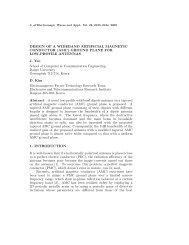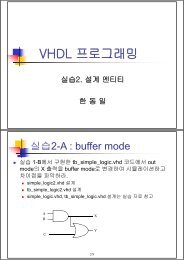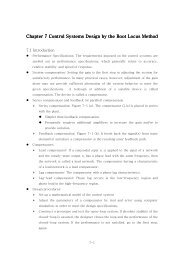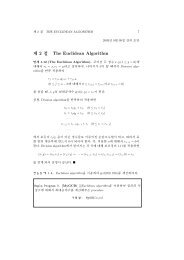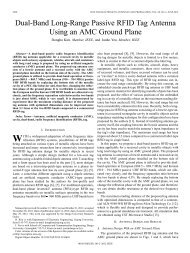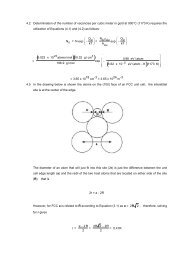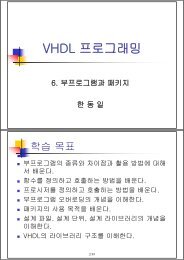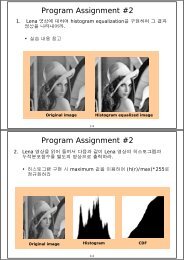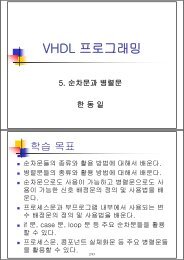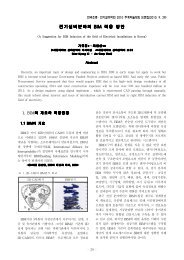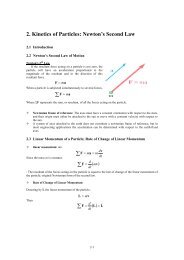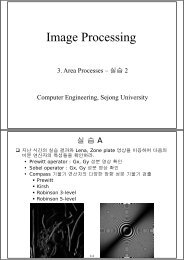Di it l Vid I t f Digital Video Interface
Di it l Vid I t f Digital Video Interface
Di it l Vid I t f Digital Video Interface
- No tags were found...
Create successful ePaper yourself
Turn your PDF publications into a flip-book with our unique Google optimized e-Paper software.
<strong>Di</strong>g<strong>it</strong>al <strong>it</strong> <strong>Vid</strong>eo <strong>Interface</strong>이병민Agenda• Pro-<strong>Vid</strong>eo Component <strong>Interface</strong>s• <strong>Vid</strong>eo Timing• Ancillary Data• 25-pin Parallel <strong>Interface</strong>• 93-pin Parallel <strong>Interface</strong>• Serial <strong>Interface</strong>• SDTV – Interlaced• SDTV – Progressive• HDTV – Interlaced• HDTV - Progressive• Pro-<strong>Vid</strong>eo Compos<strong>it</strong>e <strong>Interface</strong>s• NTSC <strong>Vid</strong>eo Timing• PAL <strong>Vid</strong>eo Timing• Ancillary Data• 25-pin Parallel <strong>Interface</strong>• Serial <strong>Interface</strong>2/71
Pro-<strong>Vid</strong>eo Component <strong>Interface</strong>s• <strong>Vid</strong>eo Timing- The video timing sequence of the encoder is controlled by three timing signalsdiscussed in Chapter4H(horizontal blanking), V(Vertical blanking), F(Field1, Field2)-A zero to one trans<strong>it</strong>ion of H triggers an EAV sequence while a one-to-zerotransis<strong>it</strong>ion triggers an SAV sequence.-F and Vallowed to change only at EAV sequence.5/71Pro-<strong>Vid</strong>eo Component <strong>Interface</strong>s• <strong>Vid</strong>eo TimingUsually, both 8-b<strong>it</strong> and 10-b<strong>it</strong> interfaces are supported,10-b<strong>it</strong> interface used to transm<strong>it</strong> 2 b<strong>it</strong>s of fractional video data to minimizecumulative processing errors and to support 10-b<strong>it</strong> ancillary data.YCbCr or R’G’B’ data may not use the 10-b<strong>it</strong> values of 000 H -003 H and 3FC H –3FF H ,or 8-b<strong>it</strong> values of 00 H and FF H , since they are used for timing information.6/71
Pro-<strong>Vid</strong>eo Component <strong>Interface</strong>sStatus t wordF = “0” for Field 1 F = “1” for Field 2V =“1” during vertical blankingH = “0” at SAV H = “1” at EAVP3-P0 = protection b<strong>it</strong>s7/71Pro-<strong>Vid</strong>eo Component <strong>Interface</strong>sIn the multiplexed sequence, the co-s<strong>it</strong>ed samples are grouped as Cb, Y, Cr.During blanking intervals, unless ancillary data is present, 10-b<strong>it</strong> Y or R’G’B’ valuesShould be set to 040 H and 10-b<strong>it</strong> CbCr values should be set to 200 H8/71
Pro-<strong>Vid</strong>eo Component <strong>Interface</strong>sThe receiver detects the EAV and SAV sequences by looking for the 8-b<strong>it</strong> FF H 00 H 00 Hpreamble.The status word is used to recover the H,V, and F timing signals.9/71Pro-<strong>Vid</strong>eo Component <strong>Interface</strong>s10/71
Pro-<strong>Vid</strong>eo Component <strong>Interface</strong>s• Ancillary Data- Ancillary data packets are used to transm<strong>it</strong> information during the blanking intervals.- ITU-R BT.1364 and SMPTE 291M describe the ancillary data formats.- During horizontal blanking, ancillary data may be transm<strong>it</strong>ted in the interval betweenthe EAV and SAV sequences.- During vertical blanking, ancillary data may be transm<strong>it</strong>ted in the interval betweenthe SAV and EAV sequences.11/71Pro-<strong>Vid</strong>eo Component <strong>Interface</strong>s• Ancillary Data- Multiple ancillary packets may be present in a horizontal or vertical blanking interval,but they must be contiguous w<strong>it</strong>h each other.- Ancillary data should not be present where indicated in Table 6.4 since theseregions may be affected by video sw<strong>it</strong>ching.12/71
Pro-<strong>Vid</strong>eo Component <strong>Interface</strong>s13/71Pro-<strong>Vid</strong>eo Component <strong>Interface</strong>s14/71
Pro-<strong>Vid</strong>eo Component <strong>Interface</strong>s- <strong>Di</strong>g<strong>it</strong>al Audio FormatITU-R BT.1305 and SMPTE 272M describe the transmission of dig<strong>it</strong>al audio asancillary data.2-16 channels of up to 24-b<strong>it</strong> dig<strong>it</strong>al audio are supported, w<strong>it</strong>h sample rates of32-48 kHz.15/71Pro-<strong>Vid</strong>eo Component <strong>Interface</strong>s20b<strong>it</strong> per sampleV: valid b<strong>it</strong>U: user b<strong>it</strong>C: channel statusP: even par<strong>it</strong>yGr : 24b<strong>it</strong>/sampleCh: 1-4 channel16/71
Pro-<strong>Vid</strong>eo Component <strong>Interface</strong>s17/71Pro-<strong>Vid</strong>eo Component <strong>Interface</strong>s18/71
Pro-<strong>Vid</strong>eo Component <strong>Interface</strong>s19/71Pro-<strong>Vid</strong>eo Component <strong>Interface</strong>s20/71
Pro-<strong>Vid</strong>eo Component <strong>Interface</strong>s21/71Pro-<strong>Vid</strong>eo Component <strong>Interface</strong>s22/71
Pro-<strong>Vid</strong>eo Component <strong>Interface</strong>s• 25-pin Parallel l <strong>Interface</strong>- This interface is used to transfer SDTV resolution 4:2:2 YCbCr data.- 8-b<strong>it</strong> or 10-b<strong>it</strong> data and a clock are transferred.- The individual b<strong>it</strong>s are labeled D0-D9, w<strong>it</strong>h D9 being the most significant b<strong>it</strong>.23/71Pro-<strong>Vid</strong>eo Component <strong>Interface</strong>s• 27 MHz Parallel l <strong>Interface</strong>- This BT.656 and SMPTE 125M interface is used for interlaced SDTV systems w<strong>it</strong>han aspect ratio of 4:3.- Y and mutiplexed CbCr information at a sample rate of 13.5 MHz are multiplexedInto a single 8-b<strong>it</strong> or 10-<strong>it</strong> data stream, at a clock rate of 27 MHz.- The 27 MHz clock signal has a clock pulse width of 18.5 ± 3 ns.- The pos<strong>it</strong>ive trans<strong>it</strong>ion of the clock signal occurs midway between data trans<strong>it</strong>ionsW<strong>it</strong>h a tolerance of ±3 ns24/71
Pro-<strong>Vid</strong>eo Component <strong>Interface</strong>sTo perm<strong>it</strong> reliable operation at interconnectLengths of 50-200 meters, Receiver must usefrequency equlization,W<strong>it</strong>h typical characteristics shown in Figure 6.3.25/71Pro-<strong>Vid</strong>eo Component <strong>Interface</strong>s• 36 MHz Parallel l <strong>Interface</strong>- This BT.1302and SMPTE 267M interface is used for interlaced SDTV systems w<strong>it</strong>han aspect ratio of 16:9.- Y and mutiplexed CbCr information at a sample rate of 18MHz are multiplexedInto a single 8-b<strong>it</strong> or 10-<strong>it</strong> data stream, at a clock rate of 36MHz.- The 36 MHz clock signal has a clock pulse width of 13.9 ± 2 ns.- The pos<strong>it</strong>ive trans<strong>it</strong>ion of the clock signal occurs midway between data trans<strong>it</strong>ionsW<strong>it</strong>h a tolerance of ±2 nsTo perm<strong>it</strong> reliable operation atinterconnectLengths of 40-160 meters, Receivermust usefrequency equlization,W<strong>it</strong>h typical characteristics shown inFigure 6.3.26/71
Pro-<strong>Vid</strong>eo Component <strong>Interface</strong>s• 93-pin Parallel l <strong>Interface</strong>- This interface is used to transfer 16:9 HDTV resolution R’G’B’ data, 4:2:2 YCbCR,or 4:2:2:4 YCbCrK data.27/71Pro-<strong>Vid</strong>eo Component <strong>Interface</strong>s• 74.25 MHz Parallel l <strong>Interface</strong>- This ITU-R BT.1120 and SMPTE 274M interface is primarily used for 16:9 HDTVsystem- The 74.25 MHz clock signal has a clock pulse width of 6.73±1.48 ns.- The pos<strong>it</strong>ive trans<strong>it</strong>ion of the clock signal occurs midway between data trans<strong>it</strong>ionsw<strong>it</strong>h a tolerance of ±1 nsTo perm<strong>it</strong> reliable operation atinterconnectLengths greater than 20 meters ,Receiver must usefrequency equlization,28/71
Pro-<strong>Vid</strong>eo Component <strong>Interface</strong>s• 148.5 MHz Parallel l <strong>Interface</strong>- This ITU-R BT.1120 and SMPTE 274M interface is primarily used for 16:9 HDTVsystem- The 148.5 MHz clock signal has a clock pulse width of 3.37±0.74 ns.- The pos<strong>it</strong>ive trans<strong>it</strong>ion of the clock signal occurs midway between data trans<strong>it</strong>ionsw<strong>it</strong>h a tolerance of ±0.5ns- To perm<strong>it</strong> reliable operation at interconnect Lengths greater than 14 meters ,Receiver must use frequency equlization,• 148.35 MHz Parallel <strong>Interface</strong>- This ITU-R BT.1120 and SMPTE 274M interface is primarily used for 16:9 HDTVsystem- The 148.5 MHz(148.5/1.001) clocksignalhasaclock a pulse width of 3.37±0.74 ns.- The pos<strong>it</strong>ive trans<strong>it</strong>ion of the clock signal occurs midway between data trans<strong>it</strong>ionsw<strong>it</strong>h a tolerance of ±0.5ns- To perm<strong>it</strong> reliable operation at interconnect Lengths greater than 14 meters ,Receiver must use frequency equlization,29/71Pro-<strong>Vid</strong>eo Component <strong>Interface</strong>s• Serial <strong>Interface</strong>- The parallel formats can be converted to a serial format (Figure 6.6)- Allowing data to be transm<strong>it</strong>ted using a 75-Ω coaxial cable(or optical fiber).- Equipment inputs and outputs both use BNC connector.- The generator has an unbalanced output w<strong>it</strong>h a source impedance of 75-Ω- The signal must be 08V±10% 0.8V peak-to-peak k measusred across a 75-Ω load.- The receiver has an input impedance of 75Ω30/71
Pro-<strong>Vid</strong>eo Component <strong>Interface</strong>s31/71Pro-<strong>Vid</strong>eo Component <strong>Interface</strong>s• 270 Mbps Serial <strong>Interface</strong>- This BT.656 and SMPTE 259M interface(also called SDI) converts a 27 MHzparallel stream into a 270 Mbps serial stream.- The 10× PLL generates a 270 MHz clock from the 27 MHz clock signal.- This interface is primarily used for 4:3 interlaced SDTV systems.• 360 Mbps Serial <strong>Interface</strong>- This BT.1302 interface converts a 36 MHz parallel stream into a 360 Mbps serialstream.- The 10× PLL generates a 360 MHz clock from the 36MHz clock signal.- This interface is primarily used for 16:9 interlaced SDTV systems.• 540 Mbps Serial <strong>Interface</strong>- This SMPTE 344M interface converts a 54 MHz parallel stream into a 540 Mbpsserial stream.- The 10× PLL generates a 540 MHz clock from the 54MHz clock signal.- This interface is primarily used for 4:3 progressive SDTV systems.32/71
Pro-<strong>Vid</strong>eo Component <strong>Interface</strong>s• 1.485 Gbps Serial <strong>Interface</strong>- This BT.1120and SMPTE 292M interface converts multiplexes two 74.25MHzparallel stream (Y and CbCr) into a single 1.485Gbps serial stream.- A 20× PLL generates a 1.485 GHz clock from the 74.25 MHz clock signal. Thisinterface is used for 16:9 HDTV systems.- Before multiplexing the two parallel streams together, line number and CRCinformation(Table 6.17) is added d to each stream after each EAV sequence.33/71Pro-<strong>Vid</strong>eo Component <strong>Interface</strong>s• 1.4835 Gbps Serial <strong>Interface</strong>- This BT.1120and SMPTE 292M interface converts multiplexes two 74.176MHz(74.25/1.001) parallel stream (Y and CbCr) into a single 1.4835(1.458/1.001)Gbpsserial stream.- A 20× PLL generates a 1.4835 GHz clock from the 74.176MHz clock signal. Thisinterface is used for 16:9 HDTV systems.- Line number and CRC information is added d as described d for the 1.485 Gbps serialinterface.34/71
Pro-<strong>Vid</strong>eo Component <strong>Interface</strong>s• SDTV – Interlaced1) 4:2:2 YCbCr Parallel <strong>Interface</strong>The ITU-R BT.656 and BT.1302 parallel interfaces were developed to transferBT.601 4:2:2 YCbCr dig<strong>it</strong>al video between equipment.35/71Pro-<strong>Vid</strong>eo Component <strong>Interface</strong>s4:316:9Both 25-pin parallel interface use 36/71
Pro-<strong>Vid</strong>eo Component <strong>Interface</strong>s2) 4:2:2 YCbCr Serial <strong>Interface</strong>BT.656 and BT.1302 define a YCbCr serial interface. The 10-b<strong>it</strong> 4:2:2 YCbCrParallel streams shown in Figure 6.9 or 6.10 are serialized using the 270 or 360 MbpsSerial interface.3) )4444Y 4:4:4:4 YCbCrK Parallel <strong>Interface</strong>ITU-R BT.799 and BT.1303 parallel interfaces were developed t transfer BT.6014:4:4:4 YCbCrK dig<strong>it</strong>al video between equipment.K is an alpha keying signal, used to mix two video sources(chapter 7)Multiplexing StructureTwo transmission links are used.Link A contains all the Y samples plus those Cb and Cr samples located at even-numbered sample points.Link B contains samples from the keying channel and the Cb and Cr sample locatedOdd-numbered sample points.37/71Pro-<strong>Vid</strong>eo Component <strong>Interface</strong>s38/71
Pro-<strong>Vid</strong>eo Component <strong>Interface</strong>s4) 4:2:2 YCbCr Serial <strong>Interface</strong>BT.656 and BT.1302 define a YCbCr serial interface. The 10-b<strong>it</strong> 4:2:2 YCbCrParallel streams shown in Figure 6.13 or 6.14 are serialized using the 270 or 360 MbpsSerial interface.39/71Pro-<strong>Vid</strong>eo Component <strong>Interface</strong>s4:316:940/71
Pro-<strong>Vid</strong>eo Component <strong>Interface</strong>s5) RGBK Parallel <strong>Interface</strong>BT.799 and BT.1303 also support transferring BT.601 R’G’B’K dig<strong>it</strong>al video betweenequipment. For add<strong>it</strong>ional information, see the 4:4:4:4 YCbCrK parallel interface.6) RGBK Serial <strong>Interface</strong>BT.799 and BT.1303 also define a R’G’B’K serial interface. The two 10-b<strong>it</strong> R’G’B’KParallel streams are serialized using two 270 r 360 Mbps serial interfaces.41/71Pro-<strong>Vid</strong>eo Component <strong>Interface</strong>s• SDTV – Progressive1) 4:2:2 YCbCr Serial <strong>Interface</strong>The ITU-R 1362 defines two 10-b<strong>it</strong> 4:2:2 YCbCr data streams(Figure 6.15), using a27MHz sample clock.42/71
Pro-<strong>Vid</strong>eo Component <strong>Interface</strong>s• HDTV - Interlaced2) 4:2:2 YCbCr Serial <strong>Interface</strong>BT.1120 define YCbCr serial interface. Figure. 6.16 , then serialized using a 1.485 or1.4835Gbps serial interface.3) 4:2:2:4 YCbCrK Parallel <strong>Interface</strong>BT.1120 also supports transferring HDTV 4:2:2:4 YCbCrK dig<strong>it</strong>al video betweenequipment.45/71Pro-<strong>Vid</strong>eo Component <strong>Interface</strong>s46/71
Pro-<strong>Vid</strong>eo Component <strong>Interface</strong>s4) RGB Parallel l <strong>Interface</strong>BT.1120 also supports transferring HDTV R’G’B’ dig<strong>it</strong>al video between equipment.₩.47/71Pro-<strong>Vid</strong>eo Component <strong>Interface</strong>s• HDTV - Progressive48/71
Pro-<strong>Vid</strong>eo Component <strong>Interface</strong>s• HDTV - Progressive1) 4:2:2 YCbCr Parallel <strong>Interface</strong>The ITU-R BT.1120 and SMPTE 274 M parallel interfaces were developed to transferprogressive HDTV 4:2:2 YCbCr dig<strong>it</strong>al video between equipment.49/71Pro-<strong>Vid</strong>eo Component <strong>Interface</strong>s50/71
Pro-<strong>Vid</strong>eo Component <strong>Interface</strong>s• HDTV - Progressive2) YCbCrK Parallel <strong>Interface</strong>The ITU-R BT.1120 and SMPTE 274 M also support transferring HDTV 4:2:2:4YCbCrK dig<strong>it</strong>al video between equipment.51/71Pro-<strong>Vid</strong>eo Component <strong>Interface</strong>s52/71
Pro-<strong>Vid</strong>eo Component <strong>Interface</strong>s• HDTV - Progressive3) RGB Parallel <strong>Interface</strong>The ITU-R BT.1120 and SMPTE 274 M also support transferring HDTV R’G’B’ dig<strong>it</strong>alvideo between equipment.53/71Pro-<strong>Vid</strong>eo Component <strong>Interface</strong>s54/71
Pro-<strong>Vid</strong>eo Compos<strong>it</strong>e <strong>Interface</strong>- <strong>Di</strong>g<strong>it</strong>al i compos<strong>it</strong>e video is essentially a dig<strong>it</strong>al i version of a compos<strong>it</strong>e analog(M) NTSC or (B,C,G,H,I) PAL video signal.The sample clock rate is four times Fsc:about 14.32 MHz for (M) NTSC and about 17.73 MHZ (B,C,G,H,I) PAL.55/71Pro-<strong>Vid</strong>eo Compos<strong>it</strong>e <strong>Interface</strong>• NTSC <strong>Vid</strong>eo Timingi56/71
Pro-<strong>Vid</strong>eo Compos<strong>it</strong>e <strong>Interface</strong>• NTSC <strong>Vid</strong>eo Timingi59/71Pro-<strong>Vid</strong>eo Compos<strong>it</strong>e <strong>Interface</strong>• NTSC <strong>Vid</strong>eo Timingi60/71
Pro-<strong>Vid</strong>eo Compos<strong>it</strong>e <strong>Interface</strong>• NTSC <strong>Vid</strong>eo Timingi61/71Pro-<strong>Vid</strong>eo Compos<strong>it</strong>e <strong>Interface</strong>• PAL <strong>Vid</strong>eo Timingi62/71
Pro-<strong>Vid</strong>eo Compos<strong>it</strong>e <strong>Interface</strong>• Ancillary DataAncillary data packets are used to transm<strong>it</strong> information(such as dig<strong>it</strong>al audio, closedcaptioning, and teletext data) during the blanking intervals.63/71Pro-<strong>Vid</strong>eo Compos<strong>it</strong>e <strong>Interface</strong>64/71
Pro-<strong>Vid</strong>eo Compos<strong>it</strong>e <strong>Interface</strong>65/71Pro-<strong>Vid</strong>eo Compos<strong>it</strong>e <strong>Interface</strong>66/71
Pro-<strong>Vid</strong>eo Compos<strong>it</strong>e <strong>Interface</strong>67/71Pro-<strong>Vid</strong>eo Compos<strong>it</strong>e <strong>Interface</strong>68/71
Pro-<strong>Vid</strong>eo Compos<strong>it</strong>e <strong>Interface</strong>• 25-pin Parallel l <strong>Interface</strong>The SMPTE 244M parallel interface is based on that used for 27 MHz 4:2:2 dig<strong>it</strong>alcomponent video (Table 6.15), except for the timing differences.This interface is used to transfer SDTV resolution dig<strong>it</strong>al compos<strong>it</strong>e data.69/71Pro-<strong>Vid</strong>eo Compos<strong>it</strong>e <strong>Interface</strong>• Serial <strong>Interface</strong>The parallel format can be converted to a SMPTE 259M serial format(Figure 6.32)70/71
Pro-<strong>Vid</strong>eo Compos<strong>it</strong>e <strong>Interface</strong>• TRS-IDWhen using the serial interface, a special five-word sequence, known as the TRS-ID, must be inserted into the dig<strong>it</strong>al video stream during the horizontal sync time.The TRS-ID is present only following sync leading edges which identify a horizontalinformation, and occupies horizontal counts 790-794, inclusive (NTSC) or 967-971,Inclusive(PAL)71/71



